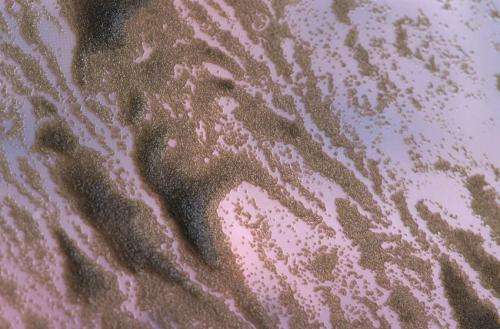Oyster larvae such as these from Oregon's Netarts Bay are vulnerable to the toxin Vibrio tubiashii. Credit: Photo by Lynn Ketchum, courtesy of Oregon State University
Scientists in the College of Veterinary Medicine at Oregon State University have developed a new, inexpensive and precise way to detect the toxin secreted by Vibrio tubiashii, a bacterial disease that a few years ago caused millions of dollars in losses to the oyster aquaculture industry in the Pacific Northwest.
When perfected and commercialized, the new assay should give oyster growers an early warning system to tell when they have a problem with high levels of this toxin and must take quick steps to address it. Findings were just published in the Journal of Microbiological Methods.
V. tubiashii has caused major problems for oyster growers in recent years, especially in 2007 when a major outbreak almost crippled the industry. When the bacteria and the toxin it produces reach unacceptably high levels, they can kill the tiny seed oysters before they have a chance to grow.
"We still need to improve the sensitivity of the test and better quantify results, but it should provide information in about 30 minutes that used to take three or four days," said Frances Biel, a faculty research assistant in the OSU Department of Biomedical Sciences. "That type of rapid detection will let oyster growers know they have a problem while they can still do something about it."
The oyster die-offs that began happening in the late 2000s appear to have various causes, researchers say, including changes in ocean acidification. Some measures were taken to help deal with the acidification, but widespread die-offs continued to occur that couldn't be linked to that problem. The vibriosis disease caused by this bacteria was found to be a major concern. The largest shellfish hatchery on the West Coast, in Oregon's Netarts Bay, faced near closure as a result of this crisis.
"Shockingly little was known about V. tubiashii at first, and the toxins that it produces," said Claudia Hase, an OSU associate professor of veterinary medicine. "It secretes a zinc-metalloprotease compound that's toxic to shellfish, and that's what our new assay is able to detect."
Besides oysters, this bacteria and toxin can also affect shrimp, clams and other marine species important to aquaculture.
The new assay uses a "dipstick" that has proven superior to another approach which was tested, and conceptually it's similar to a human pregnancy test. It uses monoclonal antibodies that recognize the particular toxic protein of concern.
Marine food farming around the world depends on hatchery and nursery production of large quantities of high quality, disease-free larvae, experts said. Vibriosis in various species has been linked to major problems around the world since the late 1970s. This and other research at OSU has made significant progress in understanding the pathogenicity and toxicity of V. tubiashii.
Aside from farmed oysters and other seafood, there have also been declines of wild shellfish in some locations in recent years on the West Coast. It's likely that increasing levels of vibriosis are related to that, researchers said. Declining coral reefs also suffer from a closely related bacterial species.
More information: ir.library.oregonstate.edu/xmlui/handle/1957/38608
Journal information: Journal of Microbiological Methods
Provided by Oregon State University






















